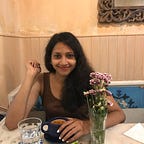Turtle Festival in Velas
Among the gently swaying casuarina trees, we made our way to the beach early morning. Sun had just risen, illuminating the beautiful black sand and we gathered around the baby turtles’ shelter. One can hear waves crashing on the shore endlessly — the best sound in the world.
A short while later, volunteers from Sahyadri Nisarga Mitra (SNM) showed up. They shared with us information about the Olive Ridley turtles and about their conservation efforts. They then proceeded to open the cane baskets that covered the baby turtles, and checked if the hatching had taken place.
Babies were taken out and placed about 20 feet from the shore. The sight of little turtles taking their first steps towards the sea and meeting the sea waves is probably the most beautiful and awe-inspiring one.
(In picture: Sunrise at Velas beach, cane baskets covering the turtle hatchlings in shelter, baby turtle making its way to the sea)
The volunteers religiously guarded the shore until the baby turtles made it to the sea, to prevent any disturbance to them through human activities on the beach. The waves carried them into the sea, and we were left back watching them in wonder.
About turtle conservation and turtle festival
Marine turtles are endangered and have been threatened with extinction in India and world over. This is due to the harvesting of turtles, poaching of their eggs and being preyed on by wild animals like jackals and hyenas. Sometimes they are accidentally caught in fishing nets or harmed by activities on the beaches.
In February 2001, evidence of turtle nesting was found in large number in Velas by SNM. Unfortunately, there were signs of poaching of eggs and attacks by jackals too. Poaching of eggs is a traditional practice in local villages lining the coast, in the entire state.
As a result, SNM, a non-profit NGO was set up to carry out marine turtle conversation in October 2002, and have protected and released more than 35,000 turtle hatch-lings in the sea so far. They try to involve other NGOs from all over the state in the endeavor and also give out ‘Kasav Mitra Puraskar’ to encourage those who volunteer for the cause.
(In picture: Baby turtles)
SNM also started the Turtle Festival in Maharashtra in Velas, and extended it to Anjarle in 2015. It is organized by Forest Department, village panchayats and Kasav Mitra Mandal. They educate the tourists about their conservation efforts, and share struggle and success stories. The tourists are also greeted with the sight of baby turtles, being born merely few hours ago, making their way into the sea. The organization has been relentlessly working towards the conservation of Olive Ridley turtles, and generously credit the local villagers for their continuous support.
Some facts about the turtles
The most interesting fact shared with us was that the female turtles come to the same beach to reproduce where they were born. They dig multiple holes in the sand, and don’t lay eggs in them until they find a suitable spot. The male turtles don’t wander far from the sea, whereas female turtles come extensively on the land to lay eggs.
Another interesting fact shared with us was the reason behind releasing the babies a certain short distance away from the sea. Turtles, babies or adults, remember the geo-magnetic field of a place once they’ve walked on it. The volunteers tag the baby turtles and shared with us that once a female turtle came back to coast of Maharashtra after wandering to Sri Lanka and another from Australia!
Nesting season is from December to January, and it takes 45 days post that period for eggs to hatch. A female turtle typically lays 100–150 eggs, and success ratio is 1:1000. The volunteers differentiate the male and female turtles by their sizes and the pattern they create on the sand. The male turtles are small in size and have long tails, whereas the female ones are larger in size and have short tails.
About Velas
Velas village and beach
Velas is a small village at the northernmost end of Ratnagiri district. The village is homely and lined with houses in bright colors. Take any road off the main road and one will be greeted with coconut and beetle nut tree farms. All houses have a traditional wooden swing in their courtyards. The villagers are warm, and served us lip-smacking Konkani thaali with spicy vegetable, bhaakri (roti made of rice), daal, rice, pickle, sol kadi and fish (staple food of the region). Do spend an evening here at the beach — yellow waves against black sand is sure to take one’s breath away!
(In pictures: Velas beach, bylanes in the village, houses in the village, Konkani thaali)
Harihareshwar temple
Popularly called Dakshin Kaashi ( Kaashi of South), it’s a famous Shiva temple situated on a hill and is a flanked by beaches on both sides. The pradakshina takes one around the hills, leading one downstairs to the sea and rocks that have beautiful niches. It is, however, not suitable to go downstairs during high tide.
(In pictures: Harihareshwar temple, pradakshina route, Harihareshwar beach)
Bankot fort
Also called Himmatgad fort, it overlooks Savitri river and Harihareshwar hill. A ferry ride takes tourists to the other side of the river, and a short distance away is the fort. It was ruled by British and Peshwas.
(In pictures: Bankot fort)
If you’ve read so far, thank you very much for your time.
If you wish to know more or offer suggestion, you can shoot me an email at nidhi.thehappychapter@gmail.com or connect with me on Instagram: @nidhigupta_
(All pictures are taken by me, unless mentioned)
(Originally published on May 27, 2019)
